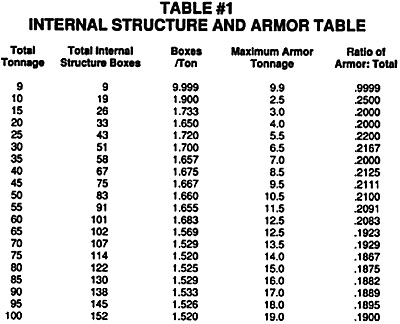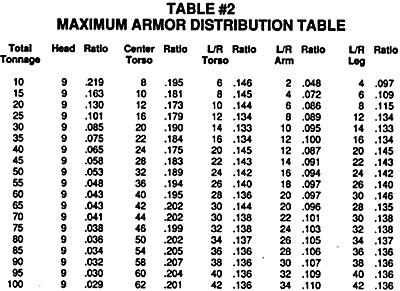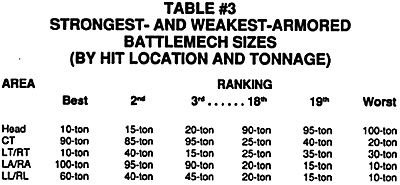As everyone well knows, combat in the 31st century is a nasty business; casualties are often staggering, both in terms of men and materiel. Yet BattleMechs-those huge fighting machines often found in the thick of things, the vehicles that make such combat possible-quite often survive somehow. Admittedly, many carry a crazy patchwork of original high-grade 'Mech armor and hastilyfitted tin foil, while others may be missing a heat sink or laser here and there.
Still, their longevity is well-described and frequently legendary; nothing can be handed down throughout the centuries from generation to generation as afamily heirloom, unless it is in one piece (more or less).
How do they last? What is their secret? Well, there appear to be several keys to a BattleMech's ability to survive:
- 1) how skilled its MechWarrior is;
2) how quickly it can move to outmaneuver the opposition;
3) whether its weapons have a long enough range to strike an opponent without being hit in return, and
4) the quantity and location of the armor physically covering the 'Mech.
Also of importance is the availability of spare parts and good technicians, but the best tool-wielders are of no immediate use after the 'Mech has left the shop and is locked in combat. This also assumes that the combat situation is roughly equal-overwhelming odds never speak well for surviving, if you are among the outnumbered party.
Once a MechWarrior is in his 'Mech and on the battlefield, though, there is little that he can do to improve substantially his chances for leaving it alive (besides beating a very hasty retreat, a method that most superiors find unsatisfactory). Skills improve only slowly, and too often, too late. When available, a few weapons may be substituted between battles for greater effect, but the engine and armor generally remain with the 'Mech from its manufacture until its final destruction. The decisive element regarding this last point armor-is ultimately determined by the vehicle's overall tonnage and internal structure, the concept to be focused on in this technical essay.
The Internal Structure
As shown on the Internal Structure Table on page 38 of BattleTech (or page 79 of The Rules of Warfare), different BattleMechs have different numbers of internal structure boxes, depending solely upon the weight of the individual 'Mech. The smallest 'Mech (at 10 tons) possesses 19 boxes allocated between its eight locations (including the head), while the largest 'Mech (at 100 tons) is equipped with 152 boxes.
As soon as the total number of internal structure boxes is known for each tonnage, one can find out the maximum allowance of armor that weight of 'Mech may carry. Keep in mind that armor must always be allocated in .5- or 1 -ton increments, and so it is necessary to round down to the nearest increment. For example, the internal structure of a 10-ton BattleMech would permit a maximum of 41 armor points. Unfortunately, the most that can ever be used is 40 (2.5 tons), and so under the best of conditions the'Mech would have one fewer armor point than the structure could conceivably hold. Of course, any model of 'Mech may carry less than its maximum allowance (and almost all do).
 Table #1 shows the total tonnage for each Nech, the total
number of internal structure boxes (added up from the BattleTech
Internal Structure Table), the number of internal structure boxes per ton
of Nech weight, the maximum tonnage of armor possible given that
internal structure, and the ratio of armor weight to the 'Mech's total
weight. Values for structure boxes per ton and armor ratios were
rounded to the nearest digit.
Table #1 shows the total tonnage for each Nech, the total
number of internal structure boxes (added up from the BattleTech
Internal Structure Table), the number of internal structure boxes per ton
of Nech weight, the maximum tonnage of armor possible given that
internal structure, and the ratio of armor weight to the 'Mech's total
weight. Values for structure boxes per ton and armor ratios were
rounded to the nearest digit.
Clearly, not all 'Mechs have been created equal. Obviously, a 100-ton 'Mech is a tougher opponent (offensively and defensively) than a 10-ton 'mech, but curiously enough, the smaller 'Mech is the more "efficient" combat vehicle--at least from a defensive standpoint. Ton for ton, the smaller 'Mech possesses more internal structure boxes, and thus more spaces on which to hang armor. This is the reason why as much as 25 percent of a lowly 10-ton 'Mech's weight may be Star Guard armor (or any other brand of your choice), compared to "only" 19 percent for a 100-tonner.
I don't mean to imply that five 20-ton Wasps or Stingers are a fair match for an Atlas. Nevertheless, one fundamental engineering maxim appears to hold true, even with BattleMechs: the larger (or bulkier, or more expensive) the system, the less inherent efficiency it has.
Sharing the Wealth
BattleMech armor is not simply lumped together to provide a defense; it must be distributed--point by point--between 11 distinct hit locations: head, center torso front, center torso rear, left torso front, left torso rear, right torso front, right torso rear, left arm, right arm, left leg, and finally right leg. The Internal Structure Table and the "Allocate Armor" section on page 40 of BattleTech (or page 80 of The Rules of Warfare) describe how many armor points each location may receive (from the maximum armor tonnage possible, given in Table #1 above).
 Table #2 summarizes the maximum number of armor points that
may be assigned to each area, and the ratio of that location's maximum
armor to that 'Mech's total number of armor points (all ratios on this table
were rounded down to the nearest digit). As mentioned above, a 10-ton
'Mech has a theoretical maximum of 41 armor points. A total of 9 armor
points may be assigned to the head, and 9 is 21.9 percent of 41 (or a
ratio of .219). Note that the front and rear torso sections are not divided
here, because this particular aspect of armor allocation is a design
choice and not a fixed design requirement.
Table #2 summarizes the maximum number of armor points that
may be assigned to each area, and the ratio of that location's maximum
armor to that 'Mech's total number of armor points (all ratios on this table
were rounded down to the nearest digit). As mentioned above, a 10-ton
'Mech has a theoretical maximum of 41 armor points. A total of 9 armor
points may be assigned to the head, and 9 is 21.9 percent of 41 (or a
ratio of .219). Note that the front and rear torso sections are not divided
here, because this particular aspect of armor allocation is a design
choice and not a fixed design requirement.
Since every BattleMech regardless of tonnage may have 9 armor points assigned to the head, it only makes sense that those points would be a far greater percentage of a small 'Mech's total armor allotment. As the 'Mechs become larger and heavier, these 9 points gradually lose their significance (except to the MechWarrior, whose life often depends on them!), as their share of the total armor finally drops to less than 3 percent.
Again, though, comparisons are being made fairly here because the distribution is on a ton-by-ton basis. In this respect, one can judge the merits of a BattleMech's armor more objectively. Since the sum of all ratios must equal 1.000 (within a few rounded off thousandths), every 'Mech will have its own strengths and weaknesses, minor variations but still worth taking note of. (When adding up all the ratios, don't forget to include two arms, two legs, and the left and right torso-they each have their own ratio.)
 The Final Analysis
The Final Analysis
Table #3 is a summary of the best- and worst-protected BattleMechs with regard to each hit location. The information was taken directly from Table #2 (though in some cases, the rankings were based on a few additional decimal places I generated that did not appear in the table shown above). The three best tonnages and the three worst tonnages show which 'Mechs may have certain strengths and weaknesses its MechWarriors should be aware of. And if the tonnage of your 'Mech isn't shown among the worst, then relax. You probably have nothing to worry about-except for that lance of Stalkers on the near horizon...
Back to BattleTechnology 5 Table of Contents
Back to BattleTechnology List of Issues
Back to MagWeb Magazine List
© Copyright 1988 by Pacific Rim Publishing.
This article appears in MagWeb (Magazine Web) on the Internet World Wide Web.
Other military history articles and gaming articles are available at http://www.magweb.com